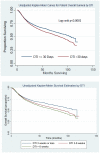Clinical impact of prolonged diagnosis to treatment interval (DTI) among patients with oropharyngeal squamous cell carcinoma
- PMID: 27086482
- PMCID: PMC4968047
- DOI: 10.1016/j.oraloncology.2016.02.010
Clinical impact of prolonged diagnosis to treatment interval (DTI) among patients with oropharyngeal squamous cell carcinoma
Abstract
Purpose/objective(s): We examined practice patterns using the National Cancer Data Base (NCDB) to determine risk factors for prolonged diagnosis to treatment interval (DTI) and survival outcomes in patients receiving chemoradiation for oropharyngeal squamous cell carcinoma (OPSCC).
Methods and materials: We identified 6606 NCDB patients with Stage III-IV OPSCC receiving chemoradiation from 2003 to 2006. We determined risk factors for prolonged DTI (>30days) using univariate and multivariable logistic regression models. We examined overall survival (OS) using Kaplan Meier and multivariable Cox proportional hazards models.
Results: 3586 (54.3%) patients had prolonged DTI. Race, IMRT, insurance status, and high volume facilities were significant risk factors for prolonged DTI. Patients with prolonged DTI had inferior OS compared to DTI⩽30days (Hazard Ratio (HR)=1.12, 95% CI 1.04-1.20, p=0.005). For every week increase in DTI there was a 2.2% (95% CI 1.1-3.3%, p<0.001) increase in risk of death. Patients receiving IMRT, treatment at academic, or high-volume facilities were more likely to experience prolonged DTI (High vs. Low volume: 61.5% vs. 51.8%, adjusted OR 1.38, 95% CI 1.21-1.58; Academic vs. Community: 59.5% vs. 50.6%, adjusted OR 1.26, 95% CI 1.13-1.42; non-IMRT vs. IMRT: 53.4% vs. 56.5%; adjusted OR 1.17, 95% CI 1.04-1.31).
Conclusions: Our results suggest that prolonged DTI has a significant impact on survival outcomes. We observed disparities in DTI by socioeconomic factors. However, facility level factors such as academic affiliation, high volume, and IMRT also increased risk of DTI. These findings should be considered in developing efficient pathways to mitigate adverse effects of prolonged DTI.
Keywords: National Cancer Data Base; Oropharyngeal cancer; Treatment delays.
Copyright © 2016 Elsevier Ltd. All rights reserved.
Figures
References
-
- Huang J. Does Delay in Starting Treatment Affect the Outcomes of Radiotherapy? A Systematic Review. J Clin Oncol. 2003;21(3):555–563. doi:10.1200/JCO.2003.04.171. - PubMed
-
- Chen Z, King W, Pearcey R, Kerba M, Mackillop WJ. The relationship between waiting time for radiotherapy and clinical outcomes: a systematic review of the literature. Radiother Oncol. 2008;87(1):3–16. doi:10.1016/j.radonc.2007.11.016. - PubMed
-
- Astit LAB, Lot EMB, Ebourdeau PHD, et al. Influence of the delay of adjuvant postoperative radiation therapy on relapse and survival in oropharyngeal and hypopharyngeal head and neck cancers. Int J Radiat Oncol Biol Phys. 2001;49(1):139–146. - PubMed
-
- Fortin A, Bairati I, Albert M, Moore L, Allard J, Couture C. Effect of Treatment Delay on Outcome of Patients with Early-Stage Head-and-Neck Carcinoma Receiving Radical Radiotherapy. Int J Radiat Oncol Biol Phys. 2002;52(4):929–936. - PubMed
-
- Rosenthal DI, Liu L, Lee JH, et al. Importance of the Treatment Package Time in Surgery and Postoperative Radiation Therapy for Squamous Carcinoma of the Head and Neck. 2002 Feb;:115–126. doi:10.1002/hed.10038. - PubMed
Publication types
MeSH terms
Grants and funding
LinkOut - more resources
Full Text Sources
Other Literature Sources




